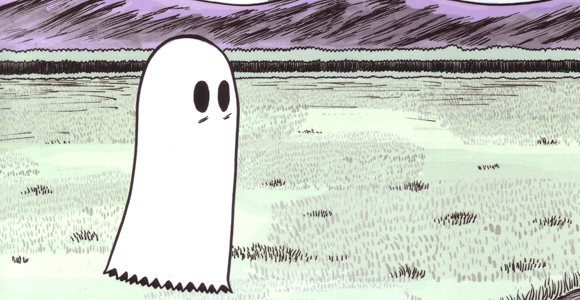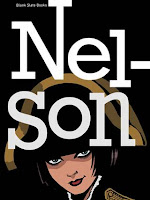2011 has been a double-edged year for comics. On the one hand, it has
been an incredibly dark year, with the world losing many great and important
figures (some far too prematurely) — Bill Blackbeard, Dylan Williams, Dwayne
McDuffie, Jerry Robinson, Bill Keane and, only recently, Joe Simon. There have been the ongoing struggles with
freedoms of expression — Syrian cartoonist Ali Ferzat having his hands broken
by authorities, Charlie Hebdo’s
offices being firebombed, Susie Cagle arrested at the Occupy Oakland protests…
It became that reading Tom Spurgeon’s Comics
Reporter each morning was almost as depressing as the front page of
/r/politics. Add to that the fact that
we had a run of three of the worst comics-based films in the fecal trifecta of Green Lantern, Captain America and Thor,
which only seemed to correlate with the general downward trajectory of most
mainstream comics…including DC’s relaunch.
On the other hand, it has been a
banner year for the medium. We’ve had
some incredible new talent emerge — in no small part thanks to the Center for
Cartoon Studies — with small, boutique publishers releasing daring, vital works
that seem to have been selling in record numbers at conventions (which, in
turn, have been reporting record attendance). Kickstarter, too, has become a
near ubiquitous platform for independent creators to launch their work and its
incentive-based pricing is rapidly emerging as the business model of the social
media age. Then, February saw the last
publisher abandon the Comics Code, leaving Archie comics finally free to
indulge in profanity, cannibalism, and sadomasochism — score one for free
speech. We’re also in a true golden age
of reprints, with Fantagraphics, IDW, Drawn & Quarterly, Humanoids and Dark
Horse continuing to put out beautiful archival editions of classic material for
new readers and working towards a true comics canon.
And, of course, in May we
launched Graphic Eye! As part of our
end-of-year celebrations, our contributors will all be revealing their Best of
2011 lists, and we’ve also invited some guest contributors to share their 2011
picks with us. We’ll be publishing one
per day for the next two weeks, so keep ’em peeled.
Thanks to all our readers who
have made our first few months such a success.
With a load of great content lined-up for the coming year — new comic
strips, more videos, bigger features — we
look forward to welcoming you all back (except the ones who were here to look
at pictures of Catwoman’s boobs… you lot can stay away.)
-- Gavin Lees
Gavin’s Top Comics of 2011
(in alphabetical
order)
Anya’s Ghost
First Second have been killing
it this year with their all-ages titles, bringing in pedigree indie talent
like Gene Yang, Faith Erin Hicks, Aaron Renier and George O’Connor to produce
mature, literate works of comics fiction.
So, it was a surprise to see newbie Vera Brosgol come along and knock
them all out of the park with her debut work.
Anya’s Ghost is not only smart, funny and beautifully illustrated, but
also has a line of healthy cynicism running through it that resists many of the
pitfalls of young adult literature.
Hemlock
I'm not normally a fan of webcomics, being something of a neo-luddite, but there was something incredibly appealing about Josceline Fenton's Hemlock. The story is rooted in Scandinavian mythology, but with some eccentric twists that make it truly her own. Fenton's artistic blend of Takeuchi Naoko and Tim Burton is beautiful to behold, and it's been impressive to see the young artist grow in her abilities over the last year, particularly in the development of her lead character. Amazingly, she's still only in college, so goodness knows what we'll see from her in the future. My money's on big things.
I Will Bite You!
This debut work from recent CCS graduate was my find of the show at
this year’s Stumptown festival. A
collection of his early strips, it shows the many facets of this young artist
and cements him as a real iconoclast of the form: the architectural lettering,
the personification of the elements, his characters’ ability to see their own
speech balloons, the near mythic scope of even his shortest strip. Lambert will be one to watch next year.
Love and Rockets: New Stories
#4
After “Browntown” in last year’s installment of New Stories, there was a worry that Jaime might have peaked — how
on earth was he going to top that story?
The achingly beautiful conclusion to “The Love Bunglers” in this volume
was the answer. Pulling together strands
from Maggie’s entire 30-year history in two pages was nothing short of
stunning, with his art as cooly confident as ever, making it a real emotional
sucker punch. Gilbert’s work developing
Fritz’s movie back-catalogue is a real mind-bender, too, weaving inter- and
meta-textual strands together that lets his characters say so much, while
saying so little. It is terrifying how
talented these guys are.
Mickey Mouse, Vol. 1
Forget Pogo and Carl Barks —
we already knew they were classics — the real reprint revelation of 2011 was
good ole’ Mickey Mouse. Before he became
sugar-coated and sanitized as the Disney mascot, Floyd Gottfredson wrote and
drew the mouse as an ass-kicking adventurer, taking him from haunted houses to
the Wild West and back again. To read
these strips is to rediscover a love for Mickey and marvel at Gottfredson’s
amazing grasp of storytelling and humour, as well as his flawless artwork. Naturally, with Fantagraphics overseeing the
reprints, the design, packaging and presentation is gorgeous — a real worthy
successor to their Peanuts series.
Nelson
This is the book that really made Blank Slate’s name as an Important
British Publisher. Nelson was collaborative graphic novel by 43 of England’s top
cartoonists, each one telling a chapter in the life of its main character. It sounds like a recipe for disaster, but the
editors managed to keep a tight rein on the proceedings and what emerged was a
brilliantly-told story of great depth and artistry. It also serves as a real who’s-who of English
cartoonists from the broadsheet darlings to the small-press upstarts. It’s also an incredibly moving trip through
British history for anyone who lived it along with Nel.
Nonplayer #1
I shouldn’t have enjoyed this anywhere near as much as I did. It was ridiculously over-hyped before its
release, was from a debut artist and was a comic about video games, of all
things. Yet, Nate Simpson showed he had
what it takes — his wholly-digital artwork had a refined, European flair to it,
recalling Moebius and Bilal, and his crafting of his fictional world inventive
enough to be engaging, and relevant enough to be thought-provoking. His painstaking artistic process (and
unfortunate recent bike accident) have meant that his work continues
agonizingly slowly, leaving installments of the series as a rare treat to be
savoured. This first issue is as
powerful a debut as one could have hoped for.
Orc Stain
Of all the off-kilter fantasy series that have begun to emerge
recently, James Stokoe’s
Orc Stain is
far and away the most off-kilter, and all the more fantastic for it. Revolving around the exploits of an orc
lock-breaker in a fantasy land that’s part Warhammer and part LSD nightmare,
the series is a great showcase for Stokoe’s insane draftsmanship and odd sense
of humour.
It’s all about dicks, you see
— dicks on every page… even the mountains look like dicks. It was the highlight of Image’s monthly
schedule, but now it seems that the artist has just given up on the series and
there’s to be no more. It was awesome
while it lasted, though.
The Someday Funnies
One of the highlights of comics journalism in the last few years was
Bob Levin’s Comics Journal feature on
this long-lost anthology of comics about the ’60s. By some incredible fluke, National Lampoon’s Michel Choquette was
able to corral all the great cartoonists of the ’70s into contributing to his
book, but after a series of rejections from publishers and finally running out
of money (Choquette seemed to live a globe-trotting lifestyle on publisher’s
advances for several years) the book was abandoned and shut away in a storage
locker. Finally, after nearly 40 years,
Abrams bring it to light and it’s every bit as wild and awe-inspiring as we
expected.
The Wolf
Tom Neely is, hands down, my
favourite artist at the moment. The way
he’s able to blend the cuteness of the Fleischer Brothers with horrifying
anatomical expressionism is a wonder in itself, but from this art he is able to
weave profound, haunting tales that meditate on the nature of art, love and
existence. The Wolf is the pinnacle of these talents — a graphic novel
entirely without words, that sees Neely experiment with a dizzying array of
artistic techniques and make a story about sex that completely transcends its
subject matter. The fact it features the
creepiest fleshless-creatures-with-Mickey-Mouse-gloves that you’ve ever seen is
just a bonus.





















































